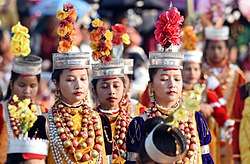Austro-Asiatic people of South Asia
 | |
| Total population | |
|---|---|
| c. 13 million | |
| Regions with significant populations | |
|
| |
| Related ethnic groups | |
| Khmers, Mon, Wa, Vietnamese and other Austroasiatic-speaking peoples |
The Austro-Asiatic people of South Asia are various distinct ethnic groups native to parts of the South Asian countries of India (Central, East, Northeast India and the Nicobar Islands), Bangladesh and Nepal who speak Austroasiatic languages.[1] They are related to other Austroasiatic-speaking peoples of Mainland Southeast Asia such as the Khmer, Mon and Vietnamese people.[1] Additionally, the Bengali people of Bangladesh and West Bengal and the Sinhalese people of Sri Lanka possess some Austro-Asiatic ancestry via gene flow from East and Northeast India.[2]
Origins
Philologist Michael Witzel argued for a language close to Munda (which he calls Para-Munda) being one of the languages of the erstwhile Indus Valley. One inconsistency is that the agricultural backbone of the Indus Valley civilisation was barley and wheat, while the Austro-Asiatic language family is spread across regions (such as Southeast Asia) where rice is the most important cultivar.[3] One theory is that rice cultivation was pioneered in China from where it spread to Southeast Asia and was brought to India by the Austro-Asiatic language speakers.[3]
References
- 1 2 Riccio et al. (2011), The Austroasiatic Munda population from India and Its enigmatic origin: a HLA diversity study.
- ↑ Hawkey, D E (1998). "Out of Asia: Dental evidence for affinity and microevolution of early and recent populations of India and Sri Lanka".
- 1 2 thehindu.com/news/national/who-built-the-indus-valley-civilisation/article22261315